|
|
Technical Reports |
| Version | Unicode 16.0.0 (draft 7) |
| Editors | Roozbeh Pournader (roozbeh@unicode.org), Bob Hallissy (bob_hallissy@sil.org), Lorna Evans (lorna_evans@sil.org) |
| Date | 2024-07-11 |
| This Version | https://www.unicode.org/reports/tr53/tr53-9.html |
| Previous Version | https://www.unicode.org/reports/tr53/tr53-8.html |
| Latest Version | https://www.unicode.org/reports/tr53/ |
| Latest Proposed Update | https://www.unicode.org/reports/tr53/proposed.html |
| Revision | 9 |
This technical report document specifies an algorithm that can be utilized during rendering for determining correct display of Arabic combining mark sequences.
This UTR UAX makes no change to Unicode normalization forms, and does not propose a new normalization form. Instead, this is similar to the processing used in [MicrosoftUSE]: a transient process which is used to reorder text for display in an internal rendering pipeline. This reordering is not intended for modifying original text, nor for open interchange.
This is a draft document which may be updated, replaced, or superseded by other documents at any time. Publication does not imply endorsement by the Unicode Consortium. This is not a stable document; it is inappropriate to cite this document as other than a work in progress.
A Unicode Technical Report (UTR) contains informative material. Conformance to the Unicode Standard does not imply conformance to any UTR. Other specifications, however, are free to make normative references to a UTR.
A Unicode Standard Annex (UAX) forms an integral part of the Unicode Standard, but is published online as a separate document. The Unicode Standard may require conformance to normative content in a Unicode Standard Annex, if so specified in the Conformance chapter of that version of the Unicode Standard. The version number of a UAX document corresponds to the version of the Unicode Standard of which it forms a part.
Please submit corrigenda and other comments with the online reporting form [Feedback]. Related information that is useful in understanding this document is found in the References. Unicode Standard Annex #41, “Common References for Unicode Standard Annexes.” For the latest version of the Unicode Standard see [Unicode]. For a list of current Unicode Technical Reports see [Reports]. For more information about versions of the Unicode Standard, see [Versions]. For any errata which may apply to this annex, see [Errata].
The assignment of Canonical_Combining_Class values for Arabic combining characters in Unicode is different than for most other scripts. It is a mixture of special classes for specific marks plus two more generalized classes for all the other marks. This has resulted in inconsistent and/or incorrect rendering for sequences with multiple combining marks since Unicode 2.0.
The Arabic Mark Transient Reordering Algorithm (AMTRA) described herein is the recommended solution to achieving correct and consistent rendering of combining character sequences containing Arabic marks. This algorithm provides results that match user expectations and assures that canonically equivalent sequences are rendered identically, independent of the order of the combining marks.
Rules and recommendations for the correct display of combining marks are discussed in a number of places in the Unicode Standard, including Section 5.13, Unknown and Missing Characters, Section 7.9, Combining Marks, and Section 9.2, Arabic in [Unicode]. Some general principles include:
In the Unicode Standard, the Arabic script combining marks include eleven different non-zero Canonical_Combining_Class values, as shown in Table 1. When a combining character sequence includes marks from more than one of these classes, the rendering system has to determine a display order in which to position these marks on the base character.
While it might be tempting to just use NFC or NFD, neither of these normalization forms will yield what Arabic readers expect. For one example that will be easily understood by all readers of Arabic script, given a combining character sequence including a shadda (ccc=33) and damma (ccc=31), NFC and NFD will move the damma before the shadda—at which point the default inside-out rendering rule would place the shadda above the damma, which is incorrect.
Some cases are obvious to readers of languages written with Arabic script, and thus will likely get the same display from various rendering implementations. However, many of the combining marks, especially those with ccc=220 and ccc=230, are not commonly understood. Different rendering implementations have made different decisions regarding display order, resulting in inconsistent behavior between one system and another.
AMTRA defines a method to reorder Arabic combining marks in order to accomplish the following goals:
Table 1: Canonical_Combining_Class Values for Marks Used in Arabic Script
| Canonical_Combining_Class (ccc) Value | Combining Marks in this Class |
|---|---|
| 0 | Combining grapheme joiner, combining alef overlay |
| 27 | fathatan, open fathatan |
| 28 | dammatan, open dammatan |
| 29 | kasratan, open kasratan |
| 30 | fatha, small fatha |
| 31 | damma, small damma |
| 32 | kasra, small kasra |
| 33 | shadda |
| 34 | sukun |
| 35 | Superscript alef |
| 220 | All other below combining marks except small low noon with kasra |
| 230 | All other above combining marks, small low noon with kasra |
The algorithm starts by reordering combining marks according to one of the Unicode Normalization forms, and then makes adjustments by moving certain marks closer to the base.
For use by this algorithm, this specification defines a group of combining marks called “Modifier Combining Marks” (MCM). This specification defines a group of combining marks called “Modifier Combining Marks” (MCM) for use by this algorithm. MCM are combining characters that are normally used to modify the base character before them, and should normally be rendered closer to the base character than tashkil (supplementary diacritics, including vowels). The MCM characters are not formally classified as ijam (consonant pointing/nukta, and so on) in the Unicode Standard, but they are usually perceived by users as ijam.
The complete list of MCM characters is defined in the Unicode Character Database (see [UAX44]) file PropList.txt.
The complete list of MCM characters is:
The set of MCM characters is intended to be stable. Adding an existing Unicode character to the list of MCM could change the rendering of data that assumes the implementation of AMTRA. Additional characters may be added to the MCM at the time they are encoded (see Section 5.4 Rationale for Exclusion of Some Marks).
In the following specification, parenthetical definitions, for example (D56), refer to definitions in the Unicode core specification.
Input: A Combining Character Sequence (D56) containing one or more Arabic combining marks.
Output: A canonically equivalent Combining Character Sequence reordered for rendering using inside-out stacking.
Steps:
Implementation note: Considering that most Arabic fonts have higher quality glyphs for precomposed characters, implementations may try to recombine base characters with a combining character immediately following them if that would result in a precomposed Unicode character. For example, if after running AMTRA the first two characters of the output are U+064A ARABIC LETTER YEH and U+0654 ARABIC HAMZA ABOVE, an implementation may want to replace them with U+0626 ARABIC LETTER YEH WITH HAMZA ABOVE. (This also helps make sure that the dots of U+064A are not displayed, even if the font is not aware of the Unicode requirement for U+064A losing its dots when combined with U+0654.)
When this step is done, implementations should not skip combining marks. For example, if the output of AMTRA is the sequence <U+0627 ARABIC LETTER ALEF, U+0670 ARABIC LETTER SUPERSCRIPT ALEF, U+0653 ARABIC MADDAH ABOVE>, an implementation may not replace the first and the third character with U+0622 ARABIC LETTER ALEF WITH MADDA ABOVE.
The following figure demonstrates the algorithm using an artificial sequence of characters:
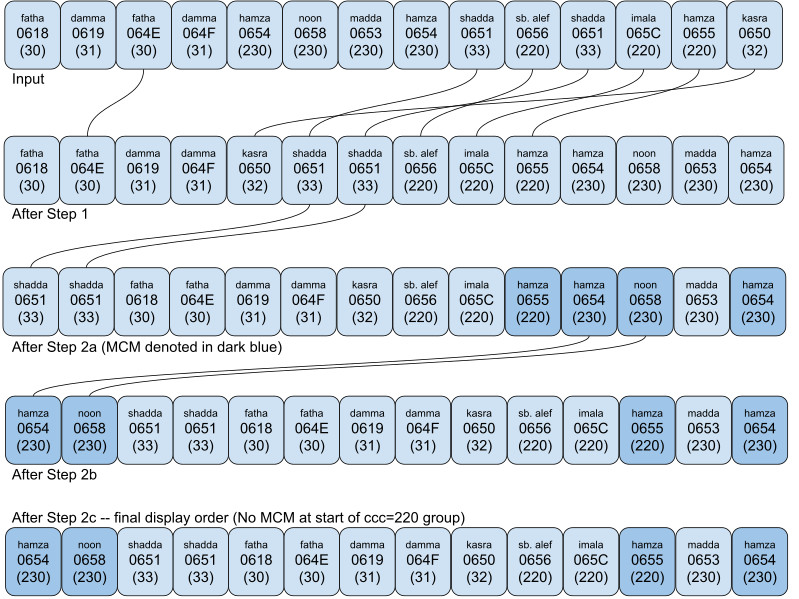
The default display order implemented by the AMTRA will be correct for most uses. However in situations where a different mark order is desired, U+034F COMBINING GRAPHEME JOINER (CGJ) can be used to achieve the desired display order. The following sections give examples of the use of CGJ.
The following examples demonstrate why each of the respective characters is included in the MCM.
The use of combining hamza above and below is discussed in Section 9.2, Arabic in [Unicode].
Example 1 [Quran1] (page 9, end of line 5)
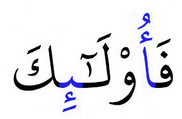
In Example 1, AMTRA puts a damma over a hamza above:
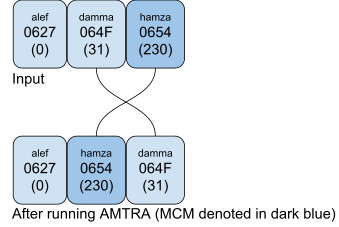
If an orthography needs to putplace the hamza above over the damma, the text should be encoded as <damma, CGJ, hamza above>:
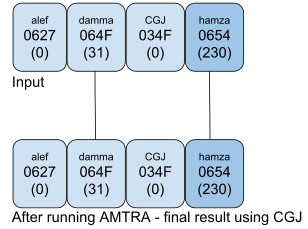
AMTRA putplace the kasra below a hamza below:
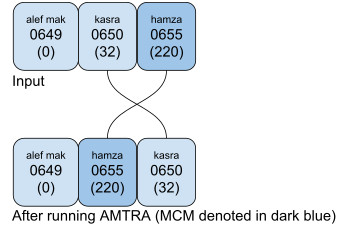
If an orthography needs to putplace the hamza below under the kasra, the text should be encoded as <kasra, CGJ, hamza below>:
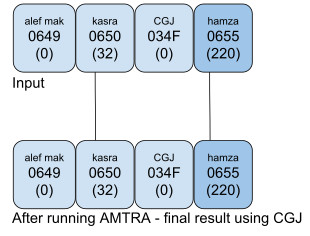
Regarding inclusion of this mark in the MCM, Kew says “The ARABIC NASALIZATION MARK is considered equivalent to a ‘nukta’, as it is a modifier that binds tightly to the underlying letter.” (italics added for emphasis) [Kew]. The character is the character encoded as U+0658 ARABIC MARK NOON GHUNNA.
ARABIC SMALL HIGH SEEN is included in MCM because most Quranic orthographies use the character as an MCM only. Orthographies that place the small seen differently will need to use a CGJ.


In Example 2a, the small high seen is rendered below the sukun, while in Example 2b, it is rendered over it. The examples are indeed from the same document (Al-Hilâlî and Khân 1996), just two pages away. The small high seen has different roles: in Example 2a it is a hint that the base letter, sad, should be pronounced as if it was a seen; in Example 2b, it is a pause-related hint.
Example 2a (characters and properties):

Running AMTRA on this string does not result in any changes.
Example 2b (characters and properties):
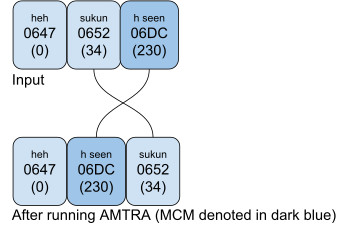
Running AMTRA on the string in Example 2b resulted in an undesired change. It puts a sukun over a seen above. If an orthography needs to putplace the seen above over the sukun, the text should be encoded as <sukun, CGJ, seen above>.
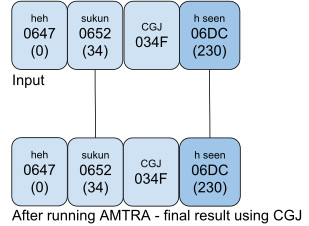
Example 3 [Milo] (page 9, line 11)
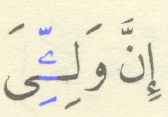
In Example 3, AMTRA puts a shadda over a small high yeh.
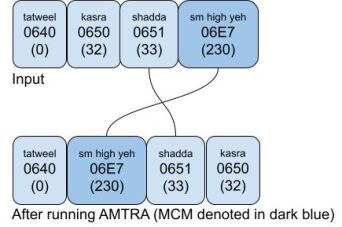
If an orthography needs to putplace the small high yeh over the shadda, the text should be encoded as <shadda, CGJ, small high yeh>.

Running AMTRA on this string does not result in any changes.
U+08F3 ARABIC SMALL HIGH WAW “is functionally similar to the already-encoded U+06E7 ARABIC SMALL HIGH YEH” and therefore small high waw is included in MCM [Pournader]. In available examples, small high waw and small low waw are functionally equivalent and, because they emphasize the vowel, are strongly bound to the body of the word. For these reasons they are both included in MCM.

Example 4a has a sukun over a small high noon. AMTRA puts a sukun over a small high noon. If an orthography needs to putplace small high noon over sukun, the text should be encoded as <sukun, CGJ, small high noon>.


Example 4b shows a practical orthography that uses small high noon for nasalization. It is theoretically possible for a vowel to appear above the small high noon in this practical orthography. In such a case, AMTRA puts the vowel (in this case damma) above small high noon.
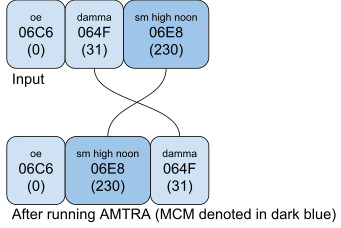
In order to force the small high noon above the vowel, use the CGJ (<oe, damma, CGJ, small high noon>).


Example 5 has a fatha over a large round dot above. AMTRA puts a fatha over a large round dot above. If an orthography needs to putplace large round dot above over fatha, the text should be encoded as <fatha, CGJ, large round dot above>.

NFD assures that sequences such as <superscript alef, madda> always result in the same ordering, independent of the base letter. If the algorithm were to usehad used NFC instead, the sequence <alef, superscript alef, madda> would have resulted in a different order of combining marks than <lam, superscript alef, madda>, because NFC composes <alef, madda> to <alef-with-madda-above>.
The Canonical_Combining_Class for shadda (ccc=33) is higher than most vowels; however, it should be displayed closer to the base than the vowels.
AMTRA is able to handle the special ligation of kasra and kasra-like characters which are ligated with a shadda or hamza in some styles and appear just below them instead of below the base letter; they still logically follow the shadda or hamza.
Meem above (ccc=230), meem below (ccc=220) and other similar characters are not included in the MCM because their behavior already meets normal expectations. Examples 6a-6c show that the combining meem is normally keptstored after fatha, kasra or damma, whereas including meem above and meem below in MCM would have the undesirable effect of moving them in front of fatha, kasra or damma.
Example 6a [Quran1] (page 11)

Example 6b [Quran1] (page 21)

Example 6c [Quran1] (page 19)

There are three sukun-like marks encoded at U+06DF..U+06E1 that are used in some Quranic orthographies to denote different entities–they may not always represent a sukun. The Canonical_Combining_Class of these marks is 230, so their ordering in the presence of other combining marks is not affected by AMTRA. However, sincebecause the combining class for the sukun is 34, these sukun-like marks will not be treated like a normal sukun in all cases. Users who create data using these alternate sukun characters will have more flexibility than when using the normal sukun. AMTRA does not make them equivalent to U+0652 ARABIC SUKUN, as that would make the algorithm unnecessarily complex and make the usage of CGJ more frequent.
Neither U+0653 ARABIC MADDAH ABOVE (ccc=230) nor U+06E4 ARABIC SMALL HIGH MADDA (ccc=230) are MCM because they are normally displayed above vowel marks.
U+10EFC ARABIC COMBINING ALEF OVERLAY (ccc=0) cannot be MCM because any character with a ccc=0 is not moved by AMTRA. The input for the example below must be lam, fatha, alef overlay, madda, and it will not be reordered by the algorithm.

Some rendering engines will insert a dotted circle for what it understandsthey understand to be an invalid sequence. This is a problem in Arabic script because something that appears invalid may actually be valid text in some lesser knownlesser-known orthography of a minority language or in the Quran. For example, the Microsoft Windows text rendering engine, described in [Microsoft], inserts a dotted circle in combinations of certain Quranic marks that are known to appear with each other in the Quran.
Such spell-checking processes are best implemented at a higher level than a rendering engine. Also, a dotted circle insertion algorithm that displays all canonically equivalent sequences identically is hard to design and the result may be counter-intuitive for its users.
Implementations of the algorithm may be adapted to insert dotted circles by applying the algorithm first and then inserting the dotted circles.
There is no intention or expectation that AMTRA would be applied to stored text.AMTRA is not intended or expected to be applied to stored text. However, there may be situations unrelated to rendering where AMTRA may be useful, and this UTRUAX does not prohibit such use.
As anFor example, when a text editor is processing a backspace key, a decision has to be made about what character(s) to remove from the text. For sequences involving combining marks, if the desire is to remove one mark at a time, users may have an expectationexpect that the outermost marks should be removed first. For Arabic script the AMTRA could be used to identify outermost marks.
When new combining marks are encoded, 220 should be used for below marks and 230 for above marks. In the special cases where an alternative version of the basic tashkil is encoded, the same Canonical_Combining_Class as the tashkil could be used, but extreme care should be taken.
U+08D9 ARABIC SMALL LOW NOON WITH KASRA
When it was added to Unicode 9.0, the small low noon with kasra (which appears below the text) was mistakenly given a ccc=230 (mark above). It should have been 220 (mark below), but that cannot now be changed. When used with other combining marks, there are a number of issues:

Roozbeh Pournader authored the initial concept. Bob Hallissy and Lorna Evans assisted Roozbeh Pournader in turning that concept into this technical report. The three co-authors and co-editors continue to contribute to this document, making various technical and editorial changes, including the classification of newly encoded Arabic combining marks.
Thanks to David Corbett, Behnam Esfahbod, Asmus Freytag, Richard Ishida, Thomas Milo, and Ken Whistler for feedback on and contributions to this document, including earlier versions.
| [Al-Hilâlî] | Muhammad Taqî-ud-Dîn Al-Hilâlî and Muhammad Muhsin Khân (translators) 1417 AH (=1996 CE). The Noble Qur’an: English Translation of the meanings and commentary. King Fahd Complex For The Printing of The Holy Qur’an. ISBN 9960-770-15-X. |
| [Feedback] | Reporting Errors and Requesting
Information Online https://www.unicode.org/reporting.html |
| [Kew] | Kew, Jonathan, 2002. Bidi committee consensus on Arabic additions from L2/01-425. L2/02-061 (accessed 1 May 2017). |
| [Microsoft] | Microsoft Typography 2014. Developing OpenType Fonts for Arabic Script. https://docs.microsoft.com/en-us/typography/script-development/arabic (accessed 16 Feb 2018). |
| [Microsoft USE] | Microsoft Typography 2017. Creating and supporting OpenType fonts for the Universal Shaping Engine. https://docs.microsoft.com/en-us/typography/script-development/use (accessed 22 May 2018). |
| [Milo] | Milo, Thomas. 2005. Annotations to the printing of the 1924 Azhar Qur'an (U+0670, U+06D6..U+06DB, U+06DD..U+06DF, U+06E0..U+06ED). L2/05-151 (accessed 1 May 2017). |
| [Pournader] | Pournader, Roozbeh. 2010. Proposal to encode four combining Arabic characters for Koranic use. L2/09-419R (accessed 2 May 2017). |
| [Quran1] | Quran example. Al-Baqarah. https://archive.org/stream/quran-pdf/002%20-%20Al-Baqarah (accessed 27 Jul 2017). |
| [Quran2] | Quran example. http://www.dailyayat.com/al-ambiya/21/88 (accessed 27 Jul 2017). |
| [Quran3] | Quran example. https://app.quranflash.com/book/Warsh2?en#/reader/chapter/565 (accessed 21 Dec 2020). |
| [Quran4] | Quran example. https://karachvi.com/quran/mushaf-al-jamahiriya.pdf (accessed 9 Nov 2023). |
| [Quran5] | Quran example. http://www.alwa7y.com/downloads/TayseerWarsh.pdf (accessed 8 Jul 2024). |
| [Reports] | Unicode Technical Reports https://www.unicode.org/reports/ For information on the status and development process for technical reports, and for a list of technical reports. |
| [Unicode] | The Unicode Standard For the latest version, see: https://www.unicode.org/versions/latest/ |
| [Versions] | Versions of the Unicode Standard https://www.unicode.org/standard/versions/ For information on version numbering, and citing and referencing the Unicode Standard, the Unicode Character Database, and Unicode Technical Reports. |
The following summarizes modifications from the previous revisions of this document.
Revision 9:
Modifications for previous versions are listed in those respective versions.
Revision 8:
Revision 7 being a proposed update, only modifications between revisions 6 and 8 are noted here.
Revision 6:
Revision 5 being a proposed update, only modifications between revisions 4 and 6 are noted here.
Revision 4:
Revision 3:
Revision 2:
Revision 1:
Copyright © 2023-2024 Unicode, Inc. All Rights Reserved. The Unicode Consortium makes no expressed or implied warranty of any kind, and assumes no liability for errors or omissions. No liability is assumed for incidental and consequential damages in connection with or arising out of the use of the information or programs contained or accompanying this technical report. The Unicode Terms of Use apply.
Unicode and the Unicode logo are trademarks of Unicode, Inc., and are registered in some jurisdictions.